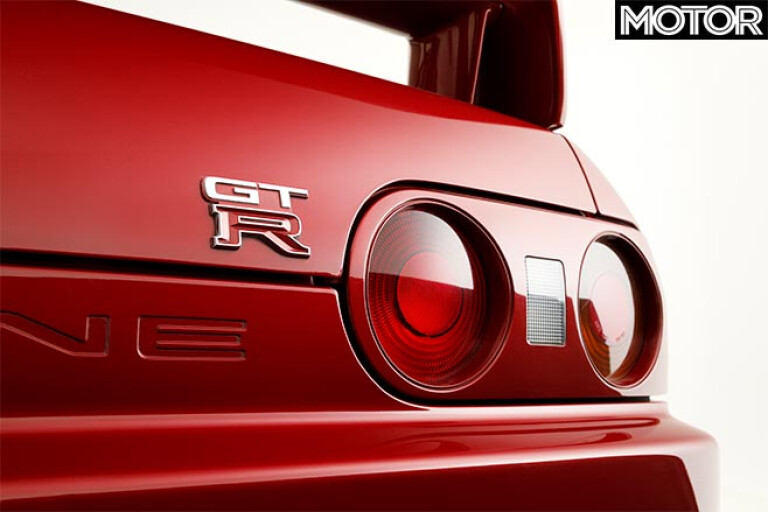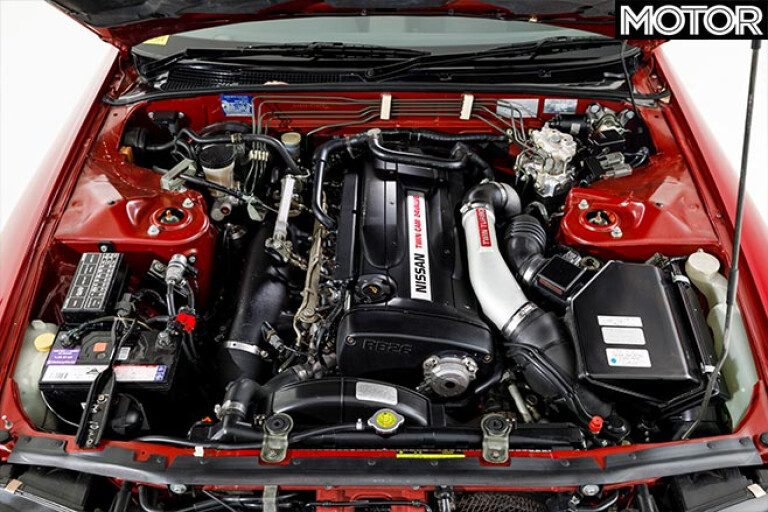
Nissan’s decision to build a car that would challenge Porsche’s fast car hegemony reverberated throughout the entire performance car world.
Locally, however, the Nissan BNR32 (‘R32’) Skyline GT-R didn’t prove quite as successful in showrooms as it did the racetracks of the Australian Touring Car Championship. Australian-complied GT-Rs arrived in 1991 priced at $110,000. Despite tricky economic times and with the cheapest Porsche 911 costing $55,000 more, the GT-R looked to be a bargain.
Nissan built Australia’s first batch of R32 GT-Rs at Murayama, Japan, in May and June 1991. The second run of 50 cars came down the same production line in August. They were then shipped to Melbourne where 50 extra hours per car were allocated to fit local compliance items including child-seat restraints, a fuel-filler restrictor and high-mount stop-light.
History of the Nissan R32 Skyline GT-R

Of the 100 cars that arrived as ‘official’ imports, 26 were painted Black Pearl Metallic with a further 37 of each in Jet Silver and Red Pearl Metallic. Reportedly just 63 of the available cars had found owners.
With a decent proportion sold to local Nissan execs and senior dealership types, just a few dozen remained for private buyers, but even those seemed impossible to move. Today, demand for R32 GT-Rs, Australian-delivered examples especially, couldn’t be stronger.
MARKET REVIEW
With almost 44,000 R32 GT-Rs built between 1989 and 1994, many have been imported privately into Australia from Japan. Lots of these cars are available and represent the bottom of the R32 GT-R ‘pile’. Too many cars in an ambivalent market (with many of them in sub-standard condition) drag down the prospects of better examples to appreciate.
Above the basic variants sits the R32 ‘V Spec’ which was sold in two editions totalling 2756 cars. Nismo and GT-R N1 versions add a combined 788 but there are just 100 in Australian specification, making locally complied cars the most collectible R32s of all.

BODY & CHASSIS
Rust should not be apparent in Australian-delivered cars, the majority of which haven’t seen enough rain to go rusty. Caution is essential with those that started life in Japan risking exposure to icy conditions. They need to be lifted and closely inspected for any corrosion or repairs. Crash damage is an issue with all GT-Rs so look for kinks to the front chassis rails, partial repaints and mismatched front or rear lenses. The extra weight of that hefty rear wing can weaken boot-lid supports and water can leak through mounting holes.
ENGINE & TRANSMISSION
The GT-R with its twin turbochargers and aging components is not something the home mechanic can ‘fix up’ on weekends. Avoiding big repair bills is best achieved by choosing a car – local or used import – that comes with recent service history. If the turbochargers haven’t been replaced or there’s no evidence of servicing at least every 5000 kilometres, assume major work will shortly be needed, and pay accordingly. White exhaust smoke indicates oil being burned in the turbochargers. Check under-bonnet hoses and plastic components for perishing and heat damage and the cylinder head for oil leaks. Rapid standing starts hurt the clutch which costs more than $1500 to replace. Listen for clunks from rear drive-shafts or the differential.

SUSPENSION & BRAKES
Check that the HICAS four-wheel steering and ABS are still operating. Many GT-Rs travel minimal distances but shock absorbers, bushes and brake components still deteriorate due to age alone. Re-kitting wheel cylinders and the booster, changing hoses and standard pads will cost more than $1500. Standard brakes fitted to GT-Rs weren’t really up to the cars’ potential and a lot will have later, larger rotors and calipers. Rotors warp due to excessive heat and pulse through the pedal. When new these cars sat high with at least a hand-depth of clearance between the tyre and wheel-arch. A car that sits noticeably nose-down or unevenly may have had its springs shortened.

INTERIOR & ELECTRICS
The GT-R interior is basic but trimmed in quality materials so a well-kept car should be on its original seats with minimal deterioration to the cabin plastics. Cars that began their working lives overseas can show wear to the seat bolsters but avoid any car that shows low kilometres and a trashed interior. The odometer will have been ‘fiddled’ or replaced. Age can afflict electrical components as well, so a full check of every switch and gauge is recommended. The air-conditioning should activate with an audible click and send a stream of cold air through the vents within 20 seconds.

IMPROVING THE BREED
Save yourself a small fortune by buying a heavily modified R32 GT-R from the get-go if you’re interested in tuning one. Modified examples outnumber stock ones by a big margin just because a whole universe of modification exists – a topic that could easily fill an entire magazine (and has), with it being so easy and relatively cheap to extract more performance from the R32 GT-R.
Nissan Skyline GT-R (R32)
Body 2-door, 4-seat coupe
Engine 2568cc inline-6, DOHC, 24v, twin-turbo
Power 206kW @ 6800rpm
Torque 355Nm @ 4400rpm
Transmission 5-speed manual
Used Range $40,000-$150,000
Other options you may consider
1. Mitsubishi 3000GT VR4 Turbo
Doesn’t drive as well but less money, rarer and weirder. A 3.0-litre east-west twin-turbo V6 sent 210kW through an all-wheel drive system and there was all-wheel steering, adaptive dampers and even active aero. 117 officially sold in Oz.
2. Porsche 911 Turbo (996)
As we wrote this, a mint ADM R32 GT-R was for sale at Dutton Garage, Melbourne, for $150K. If you’re spending that much, you must consider Porsche’s early-2000s 309kW twin-turbo flat-six rocket. Clean manual examples for around $100K.
3. Nissan 200SX (S15)
Not as special, but same compact, Nissan 1990s-ish turbocharged sports car feel, and yet newer, safer, lighter and possibly more fun. Rear-drive, turbo 2.0-litre inline-4, 147kW and easily tuned (although don’t you dare). These days $30K for a clean example.

COMMENTS